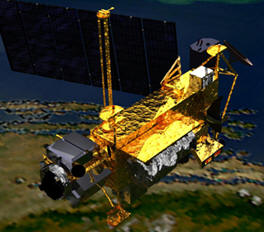|
|||||||||||||||||
|
|
|
|||
|
NASA's UARS
Satellite Re-Enters Earth's Atmosphere By Bill Goldston |
||||
 |
September 25, 2011 - NASA’s decommissioned Upper
Atmosphere Research Satellite (UARS) fell back to Earth
on Friday between 11:23 p.m. EDT and 1:09 a.m. 20 years
and nine days after its launch on a 14-year mission that
produced some of the first long-term records of
chemicals in the atmosphere. The precise re-entry time and location of debris impacts have not been determined. During the re-entry period, the satellite passed from the east coast of Africa over the Indian Ocean, then the Pacific Ocean, then across northern Canada, then across the northern Atlantic Ocean, to a point over West Africa.
The vast majority of the orbital transit was over water,
with some flight over northern Canada and West Africa. |
|||
|
Data
indicates the satellite likely broke apart and landed in the
Pacific Ocean far off the U.S. coast. Twenty-six satellite
components, weighing a total of about 1,200 pounds, could have
survived the fiery re-entry and reach the surface of Earth.
However, NASA is not aware of any reports of injury or property
damage.
The
Operations Center for JFCC-Space, the Joint Functional Component
Command at Vandenberg Air Force Base, Calif., which works around
the clock detecting, identifying and tracking all man-made
objects in Earth orbit, tracked the movements of UARS through
the satellite’s final orbits and provided confirmation of
re-entry.
“We extend
our appreciation to the Joint Space Operations Center for
monitoring UARS not only this past week but also throughout its
entire 20 years on orbit,” said Nick Johnson, NASA’s chief
scientist for orbital debris, at NASA’s Johnson Space Center in
Houston.
UARS was launched Sept. 12, 1991, aboard space shuttle mission STS-48 and deployed on Sept. 15, 1991. It was the first multi-instrumented satellite to observe numerous chemical components of the atmosphere for better understanding of photochemistry. UARS data marked the beginning of many long-term records for key chemicals in the atmosphere. The satellite also provided key data on the amount of light that comes from the sun at ultraviolet and visible wavelengths. UARS ceased its scientific life in 2005. |
||||


